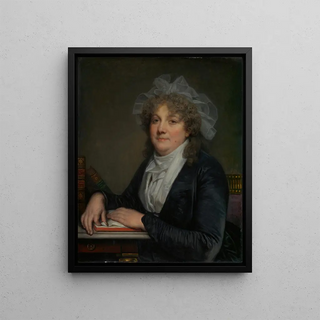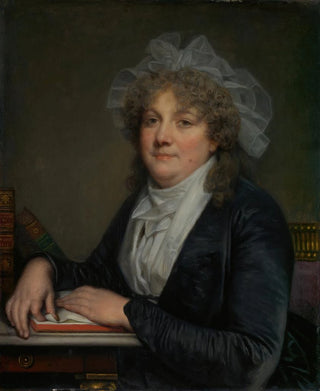Art print | Madame Jean-Baptiste Nicolet Anne Antoinette Desmoulins 1743-1817 - Jean-Baptiste Greuze


View from behind

Frame (optional)
Madame Jean-Baptiste Nicolet Anne Antoinette Desmoulins Art print by Jean-Baptiste Greuze – Captivating Introduction
The painting "Madame Jean-Baptiste Nicolet Anne Antoinette Desmoulins" by Jean-Baptiste Greuze, created in the 18th century, embodies the elegance and sophistication of an era marked by social and cultural upheavals. This work, depicting a woman of high bourgeoisie, serves as a true window into the past, revealing not only the beauty of the subject but also the subtleties of the historical context in which it was created. Greuze, through his mastery of portraiture, succeeds in capturing the very essence of his model, offering a fascinating insight into the customs and values of his time. The piece, both intimate and universal, invites viewers to reflect on the identity and role of women in a society undergoing rapid change.
Style and uniqueness of the work
Greuze's style is distinguished by his ability to combine realism and sensitivity. In this depiction, the delicacy of Madame Desmoulins' features is accentuated by soft lighting that caresses her face, highlighting the nuances of her expression. The meticulous details of her attire, with sumptuous fabrics and refined accessories, testify to exceptional craftsmanship and a particular attention to the fashion of the period. The composition is carefully balanced, with each element contributing to the harmony of the whole. Greuze manages to create an intimate atmosphere, almost tangible, where the presence of the model is felt beyond the canvas. This ability to breathe life and emotion into his portraits makes this work a key piece of the genre, where the beauty of the woman blends with striking psychological depth.
The artist and his influence
Jean-Baptiste Greuze, born in 1725, is one of the most influential artists of his time, recognized for his contribution to portraiture and genre painting. His artistic vision, which emphasizes emotion and storytelling, fits within a transitional context between Rococo and Neoclassicism. Greuze was able to capture the spirit of his era while anticipating stylistic evolutions to come. His innovative approach, which values feelings and

Matte finish

View from behind

Frame (optional)
Madame Jean-Baptiste Nicolet Anne Antoinette Desmoulins Art print by Jean-Baptiste Greuze – Captivating Introduction
The painting "Madame Jean-Baptiste Nicolet Anne Antoinette Desmoulins" by Jean-Baptiste Greuze, created in the 18th century, embodies the elegance and sophistication of an era marked by social and cultural upheavals. This work, depicting a woman of high bourgeoisie, serves as a true window into the past, revealing not only the beauty of the subject but also the subtleties of the historical context in which it was created. Greuze, through his mastery of portraiture, succeeds in capturing the very essence of his model, offering a fascinating insight into the customs and values of his time. The piece, both intimate and universal, invites viewers to reflect on the identity and role of women in a society undergoing rapid change.
Style and uniqueness of the work
Greuze's style is distinguished by his ability to combine realism and sensitivity. In this depiction, the delicacy of Madame Desmoulins' features is accentuated by soft lighting that caresses her face, highlighting the nuances of her expression. The meticulous details of her attire, with sumptuous fabrics and refined accessories, testify to exceptional craftsmanship and a particular attention to the fashion of the period. The composition is carefully balanced, with each element contributing to the harmony of the whole. Greuze manages to create an intimate atmosphere, almost tangible, where the presence of the model is felt beyond the canvas. This ability to breathe life and emotion into his portraits makes this work a key piece of the genre, where the beauty of the woman blends with striking psychological depth.
The artist and his influence
Jean-Baptiste Greuze, born in 1725, is one of the most influential artists of his time, recognized for his contribution to portraiture and genre painting. His artistic vision, which emphasizes emotion and storytelling, fits within a transitional context between Rococo and Neoclassicism. Greuze was able to capture the spirit of his era while anticipating stylistic evolutions to come. His innovative approach, which values feelings and






